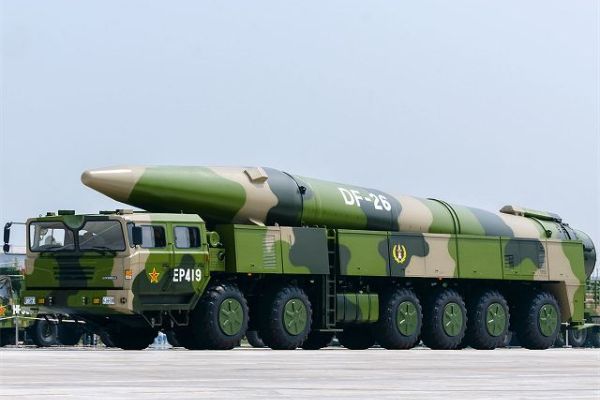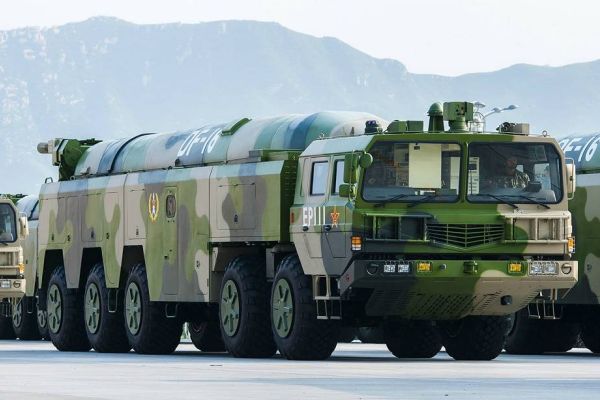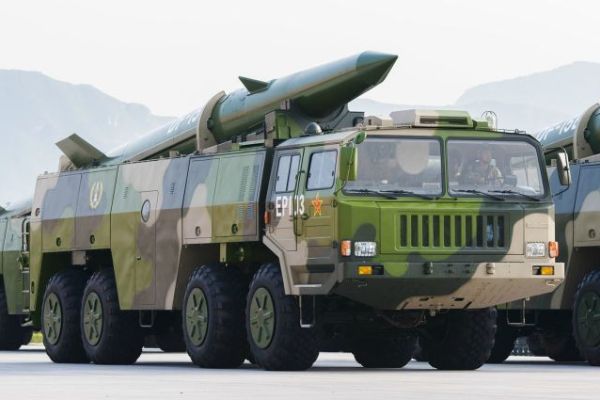Ballistic Missiles.
PrSM Precision Strike Missile.

The Precision Strike Missile (PrSM) is the U.S. Army’s next-generation surface-to-surface missile system, designed to deliver extended-range, high-precision firepower against high-value and time-sensitive targets in highly contested environments. Developed by Lockheed Martin Missiles and Fire Control, the PrSM is part of the Army’s top modernization priority under the Long Range Precision Fires (LRPF) initiative. The missile offers a decisive improvement over legacy systems, particularly the MGM-140 ATACMS, with enhanced range, accuracy, lethality, and adaptability for future multi-domain operations.
Country users: United States
Description
The Precision Strike Missile (PrSM) is a tactical ballistic missile system developed to extend the U.S. Army’s deep-strike capability and increase its ability to suppress, neutralize, or destroy high-value enemy targets at operational depths. Manufactured by the American Company Lockheed Martin, PrSM is launched from mobile platforms such as the M142 HIMARS and the M270A2 MLRS and is designed to outpace the limitations of the older ATACMS missile system by offering greater range, improved targeting systems, and future growth potential.
Conceived in the mid-2010s under the LRPF (Long Range Precision Fires) modernization program, the PrSM program began as a competitive development effort, with Lockheed Martin ultimately chosen as the primary contractor. Emphasis was placed on increasing missile range, reducing maintenance and radar signature, and expanding payload flexibility—all within a compact, modular design compatible with existing Army launcher infrastructure.
Flight testing began in 2019 at White Sands Missile Range, New Mexico, with each successive test confirming incremental performance gains. By 2023, the missile had achieved test ranges over 400 kilometers. In December 2023, Lockheed Martin was awarded a Low-Rate Initial Production (LRIP) contract to begin early fielding of Increment 1 missiles, marking the start of its transition to operational deployment.
On April 14, 2025, Lockheed Martin and the U.S. Army reached a significant program milestone by conducting the first successful launch of the Precision Strike Missile from the upgraded M270A2 Multiple Launch Rocket System (MLRS). This production qualification test, held at White Sands Missile Range, validated not only the missile’s integration with the M270A2 but also confirmed its accuracy, lethality, and system reliability under operational stress conditions. Although conducted as a short-range test, the event was critical in demonstrating full compatibility between the missile and the upgraded launcher platform, paving the way for broader fielding of PrSM across all U.S. Army artillery brigades.
The primary role of the PrSM is to enable precision strikes against a wide array of targets, including integrated air defense systems, command and control facilities, missile launchers, logistics hubs, and other time-sensitive objectives. It is also designed with modularity in mind, allowing the integration of future enhancements such as terminal seekers and multi-mode payloads. The PrSM system offers a powerful, flexible, and survivable solution for deep fires in joint all-domain operations by operating from mobile launchers and being networked with Army and Joint targeting systems.
According to information published by the U.S. Army on July 6, 2025, the service’s Precision Strike Missile (PrSM) Increment 1 program achieved Milestone C approval on July 2, 2025, officially transitioning to the Production and Deployment phase. This decision marks a major advancement in the U.S. Army’s long-range precision fires modernization effort, as PrSM Increment 1 is now cleared for full-rate production to equip artillery units with a powerful new missile capable of engaging targets beyond 400 kilometers.
PrSM variants:
- PrSM Increment 1: The baseline operational variant, currently in low-rate initial production and entering field service. It features a unitary high-explosive warhead, GPS/INS guidance, and a range exceeding 400 km. Compatible with HIMARS and M270A2 launchers, it is designed for stationary target engagement under all-weather, day/night conditions.
- PrSM Increment 2 (In Development): This variant adds a multi-mode terminal seeker, enabling the missile to engage moving and maritime targets, such as ships or mobile air defense systems. Range is increased to over 500 km, and the seeker options may include imaging infrared (IIR), active radar, or semi-active laser guidance. It significantly expands PrSM’s versatility for joint and multi-domain operations.
- PrSM Increment 3 (Conceptual/Future): A future advanced variant aimed at extending the missile’s range to up to 1,000 km or more. Expected improvements include enhanced propulsion (possibly dual-pulse motors), further optimized aerodynamics, reduced weight, and improved lethality. Increment 3 is intended to provide long-range strike capabilities at strategic depths, bridging the gap between tactical missiles and theater-level systems.
Technical Data
-
Design
The PrSM (Precision Strike Missile) features a clean, cylindrical design, measuring approximately 4 meters in length and 430 mm in diameter, housed in a sealed, launch-ready pod compatible with both the M142 HIMARS and the M270A2 MLRS. Each launcher pod holds two missiles, doubling the load-out capacity when compared to the ATACMS system, which carried one missile per pod. This dual-load configuration significantly increases the strike volume per platform, especially in rapid, sequential launch operations.
The airframe is constructed from advanced lightweight composite materials, engineered for structural integrity under high thermal and aerodynamic stress. Fixed rear-mounted control fins provide aerodynamic control during flight, eliminating the need for deployable wings or doors. This design choice improves mechanical reliability and reduces maintenance requirements in the field.
Because the missile is fully containerized and fire-ready, launch preparations are minimal, and reloads can be conducted quickly using standard logistics vehicles. Its compact profile and compatibility with existing launchers also ensure logistical simplicity and global deployability.
-
Propulsion
The PrSM is powered by a solid-fueled, single-stage rocket motor developed for high-velocity, long-range strike missions. The propulsion system is optimized for rapid launch acceleration and stable supersonic cruise toward the target area. The motor uses a solid propellant composition specifically engineered for energy efficiency and storability, allowing the missile to remain ready for extended periods without degradation.
Critically, the missile complies with Insensitive Munitions (IM) standards, enhancing operational safety and survivability. Its motor casing and explosive fill are designed to resist sympathetic detonation from external fires or impacts, providing improved safety for handling, storage, and transport.
In its initial configuration (Increment 1), the PrSM has demonstrated a range beyond 400 km, nearly doubling the ATACMS’s reach. Increment 2, already in the engineering and manufacturing development (EMD) phase, will increase that range to over 500 km and incorporate new targeting capabilities. Increment 3, expected in the late 2020s, could see the system’s reach extended to 1,000 km or more through upgraded propulsion, optimized aerodynamics, and lighter structural materials.
The missile’s trajectory is controlled solely by aerodynamic tail fins, with no thrust vectoring system required. This simplifies the propulsion architecture, reduces mechanical complexity, and increases mean time between failures.
-
Guidance Systems
Navigation and targeting are handled by a highly resilient and precise hybrid system. The PrSM uses a GPS-aided Inertial Navigation System (INS), providing redundant, all-weather targeting capability with resilience against jamming or spoofing. In GPS-contested environments, the INS ensures course stability and positional awareness through advanced gyroscopic and accelerometer-based tracking.
Under normal conditions, the GPS system allows for precision guidance with an expected sub-meter CEP (Circular Error Probable). This level of accuracy makes PrSM exceptionally effective at striking hardened or pinpoint targets with minimal collateral damage.
Beginning with Increment 2, the PrSM will feature a multi-mode terminal seeker capable of engaging moving or relocatable targets. Options under development include active radar, infrared imaging (IIR), and semi-active laser (SAL) seekers. These capabilities will allow future versions of the missile to autonomously track and strike mobile air defense systems, enemy ships, or high-value mobile command vehicles, even in complex or cluttered environments.
The integration of advanced guidance systems also enables PrSM to operate in multi-domain environments, coordinating with aerial or space-based ISR assets for mid-course updates or dynamic re-targeting.
-
Warhead
The Precision Strike Missile is currently equipped with a unitary high-explosive (HE) warhead, optimized for the destruction of high-value fixed targets with maximum lethality and precision. Although the exact specifications remain classified, the warhead is believed to be a refined evolution of the one used in the MGM-140 ATACMS, offering improved explosive effects and fragmentation performance. Designed to defeat both soft and semi-hardened targets, the warhead delivers concentrated blast energy and directional fragmentation upon impact, making it effective against infrastructure such as command bunkers, radar stations, logistics depots, and aircraft shelters. Thanks to its high terminal accuracy, typically within sub-meter CEP, the missile ensures efficient kill effects with a single strike, minimizing the need for follow-up fires and reducing collateral damage. Future variants of the PrSM may incorporate alternative payloads, including multi-effect warheads or submunition-based payloads—subject to evolving operational requirements and international munitions treaties—offering even greater flexibility and scalability for different target sets.
-
Combat Use
The Precision Strike Missile (PrSM) is designed to be launched from two primary U.S. Army artillery platforms: the M142 HIMARS and the M270A2 MLRS. These highly mobile, digitally networked launchers allow the PrSM to be integrated seamlessly into existing fire support structures and joint command-and-control networks. The use of containerized, two-round launch pods enables each launcher to carry and fire two missiles, thereby doubling the strike volume compared to previous systems like ATACMS, which carried only one missile per pod. This increase in onboard munitions enhances operational tempo and enables massed fires without requiring additional launch platforms.
The launchers themselves are operated through the Army’s Advanced Field Artillery Tactical Data System (AFATDS), allowing for rapid fire mission processing, digital targeting, and real-time integration with joint and coalition assets. Once launched, the missile can execute long-range strikes with minimal launch signature and rapid time-to-target, enabling it to hit priority enemy assets far beyond the front lines. The mobility of both HIMARS and M270A2 systems allows PrSM-equipped units to employ “shoot-and-scoot” tactics—firing rapidly and then relocating to avoid counter-battery detection and strikes—thereby increasing survivability in high-threat environments.
In terms of operational application, the PrSM is optimized to destroy a wide variety of high-value and time-sensitive targets. These include integrated air defense systems, enemy command-and-control facilities, forward-deployed missile or rocket launchers, logistical and supply nodes, airfields, radar installations, and other critical battlefield infrastructure. The missile’s unitary high-explosive warhead is designed to neutralize both soft and moderately hardened targets with precision, minimizing collateral damage and increasing effectiveness against targets embedded in civilian or complex terrain.
The missile is also capable of being deployed under all-weather conditions, day or night, ensuring 24/7 operational availability. As future increments of the missile are fielded, especially those featuring multi-mode seekers, the PrSM will expand its combat utility to include the engagement of moving or maritime targets. This evolution will allow the missile to support cross-domain fires in the maritime environment, providing the Army with a land-based anti-ship capability previously unavailable to ground forces.
Ultimately, PrSM gives commanders a precision deep-strike weapon capable of shaping the battlespace before close engagement occurs. It enables suppression of enemy air defenses, disruption of command networks, and the destruction of critical logistical infrastructure from well outside enemy reach. In a theater like the Indo-Pacific or Eastern Europe, where standoff strike capabilities are essential, the PrSM offers a scalable, survivable, and highly lethal option for rapidly neutralizing strategic targets and maintaining battlefield momentum.
Specifications
-
Type
Surface-to-surface tactical ballistic missile
-
Country users
United States (initial operator); potential for allied exports (e.g., Australia, UK, Poland under consideration)
-
Designer Country
United States (developed and manufactured by Lockheed Martin Missiles and Fire Control)
-
Guidance Systems
- Inertial Navigation System (INS) + GPS (Increment 1)
- Multi-mode terminal seeker (Increment 2 and 3 – under development) -
Launcher Vehicles
- M142 HIMARS (wheeled)
- M270A2 MLRS (tracked) -
Accuracy
Sub-meter Circular Error Probable (CEP) with GPS guidance
-
Weight Missile
Approximately 816 kg
-
Speed Missile
High-subsonic to low-supersonic (exact figures classified)
-
Range Missile
- Over 400 km (Increment 1)
- Over 500 km (Increment 2 – in development)
- Up to 1,000 km (Increment 3 – conceptual/future) -
Dimensions
Length: 4.0 m; Diameter: 0.43 m; Height: ? m











































